En Route to Punta de Antiquera, Tenerife
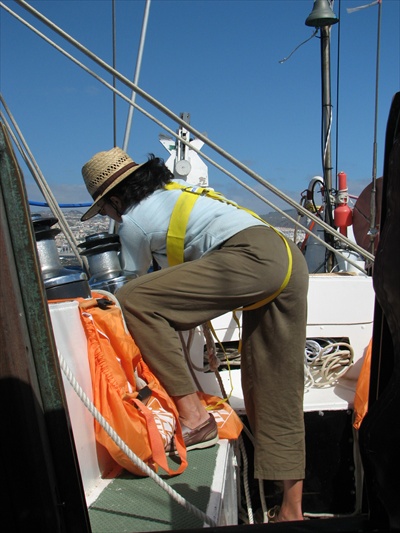 A typical power struggle between me and the mainsail cam cleat. It’s made of wood, is the size of a small lobster, and is stubborn as heck. One really needs to throw one’s back(side) into the job.
A typical power struggle between me and the mainsail cam cleat. It’s made of wood, is the size of a small lobster, and is stubborn as heck. One really needs to throw one’s back(side) into the job. 
Monthly Archives: July 2008
Cruising and Smiling
En Route to Punta de Antiquera, Tenerife
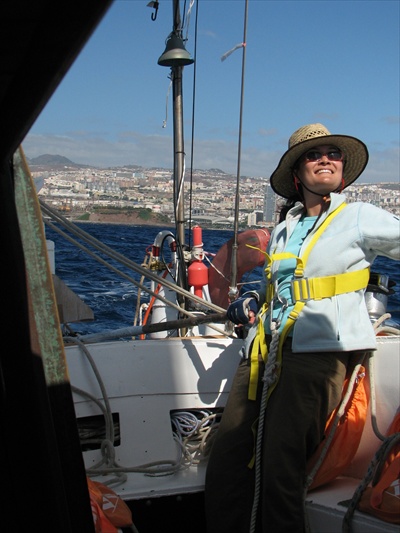 The perpetual sun, intense blue skies and steady breezes of the Canaries are enough to make anyone smile. That’s the city of Santa Cruz in the background.
The perpetual sun, intense blue skies and steady breezes of the Canaries are enough to make anyone smile. That’s the city of Santa Cruz in the background.
Lost Rudder
East of Tenerife, 28 30.6’N:16 1.3’W
 Richard successfully repaired the engine in Las Palmas, Gran Canaria. Yahoo! Just in time for us to depart and pick up George who would be returning to Santa Cruz, Tenerife, on Sat. 7/12. On Friday, July 11th, Richard and I readied the boat in the early morning, and peacefully departed the harbor of Las Palmas.We set our sails for the 50 mile journey to the anchorage of Punta de Antiquera, Tenerife, a few miles above our final destination of Santa Cruz. We would anchor at Punta de Antiquera for one night before continuing on to Tenerife the next day, as a way to break up the trip.What a glorious sail! The sun beat down brilliantly, the wind drove the boat at 7 knots, and the waves broke over the bow, boisterously billowing across the deck like frilly-skirted Can-Can girls. Other than the surrounding blue, our only other companions were mysterious, brown-backed sea birds who swooped and wheeled above the sea, taunting the waves, hunting for small, ill-fated fish just beneath the surface. By 18:20, we had only 13 miles to go to our anchorage, and we were still cookin’ with gas at 7 knots! It was at this point that Richard noticed the rudder squeaking, this time loudly, and he decided to grease the pintles while I kept watch for traffic.Now, allow me to interject that one of Richard’s many charming qualities is that he almost NEVER curses. So when I heard Richard quietly say, “Oh sh*t,” I knew something was wrong.I turned around to see Richard bent over the stern of the boat in pretzel form, holding onto something with some effort. I looked over Richard’s shoulder and saw a big white thing dangling and dragging off the back of the boat. What is that? An albino dolphin? No, it’s the rudder…that’s come off. Double YIKES! Richard instructed me to get some extra lines that he used to lash the rudder more firmly to the boat, and we then towed it. While Richard was busy securing the rudder, I’m quite pleased to report that I somehow managed to wait a full ten (anxiety-ridden) minutes before I asked Richard, “Do we need to call for help?” to which he replied, “No, why would we need to?” Perplexed, I replied, “Ummm, because we have no steering and we’re in the middle of the ocean?” Richard looked at me quizzically, and said, “We can use the main rudder.” Oh. Oh! In all the time that I had been on the boat, I had not realized that we had been steering with the AUXILIARY rudder. What an overwhelming relief to learn that we had another rudder to steer with. PHEW! I was wondering why Richard was behaving so calmly while I was ready to set off all the flares on the boat. So, we switched to steering with the wheel which is connected to the main rudder. In spite of dragging our “coattail” rudder, we managed to sail safely into our isolated and ruggedly beautiful anchorage of Punta de Antiquera, and anchored in 8 meters. In the quickly waning light of the sun sinking behind the cliffs, Richard and I brought the auxiliary rudder aboard with the fisherman halyard, and laid it to temporary rest on the deck, where it resembled an unconscious, beached whale (big boat, big rudder). It was a meditative moment.Exhausted, we went to sleep almost immediately after anchoring, the tranquility of sleep only being temporarily interrupted by Richard noticing at 05:00 that the anchor had dragged about 150 meters. In silent, sleepwalking, automaton fashion, we re-anchored and then slept peacefully until after daybreak. Time to get the boat ready for our sail to Santa Cruz, pick up George, and repair the auxiliary rudder. Ah, sailing….always an adventure. :)In the picture above, the red thing you see to the left is the windvane blade, that turns the auxiliary rudder to steer the boat at a constant course relative to the wind. When not sailing offshore, we disconnect the windvane from the auxiliary rudder and attach a tiller to the auxiliary rudder to steer manually.
Richard successfully repaired the engine in Las Palmas, Gran Canaria. Yahoo! Just in time for us to depart and pick up George who would be returning to Santa Cruz, Tenerife, on Sat. 7/12. On Friday, July 11th, Richard and I readied the boat in the early morning, and peacefully departed the harbor of Las Palmas.We set our sails for the 50 mile journey to the anchorage of Punta de Antiquera, Tenerife, a few miles above our final destination of Santa Cruz. We would anchor at Punta de Antiquera for one night before continuing on to Tenerife the next day, as a way to break up the trip.What a glorious sail! The sun beat down brilliantly, the wind drove the boat at 7 knots, and the waves broke over the bow, boisterously billowing across the deck like frilly-skirted Can-Can girls. Other than the surrounding blue, our only other companions were mysterious, brown-backed sea birds who swooped and wheeled above the sea, taunting the waves, hunting for small, ill-fated fish just beneath the surface. By 18:20, we had only 13 miles to go to our anchorage, and we were still cookin’ with gas at 7 knots! It was at this point that Richard noticed the rudder squeaking, this time loudly, and he decided to grease the pintles while I kept watch for traffic.Now, allow me to interject that one of Richard’s many charming qualities is that he almost NEVER curses. So when I heard Richard quietly say, “Oh sh*t,” I knew something was wrong.I turned around to see Richard bent over the stern of the boat in pretzel form, holding onto something with some effort. I looked over Richard’s shoulder and saw a big white thing dangling and dragging off the back of the boat. What is that? An albino dolphin? No, it’s the rudder…that’s come off. Double YIKES! Richard instructed me to get some extra lines that he used to lash the rudder more firmly to the boat, and we then towed it. While Richard was busy securing the rudder, I’m quite pleased to report that I somehow managed to wait a full ten (anxiety-ridden) minutes before I asked Richard, “Do we need to call for help?” to which he replied, “No, why would we need to?” Perplexed, I replied, “Ummm, because we have no steering and we’re in the middle of the ocean?” Richard looked at me quizzically, and said, “We can use the main rudder.” Oh. Oh! In all the time that I had been on the boat, I had not realized that we had been steering with the AUXILIARY rudder. What an overwhelming relief to learn that we had another rudder to steer with. PHEW! I was wondering why Richard was behaving so calmly while I was ready to set off all the flares on the boat. So, we switched to steering with the wheel which is connected to the main rudder. In spite of dragging our “coattail” rudder, we managed to sail safely into our isolated and ruggedly beautiful anchorage of Punta de Antiquera, and anchored in 8 meters. In the quickly waning light of the sun sinking behind the cliffs, Richard and I brought the auxiliary rudder aboard with the fisherman halyard, and laid it to temporary rest on the deck, where it resembled an unconscious, beached whale (big boat, big rudder). It was a meditative moment.Exhausted, we went to sleep almost immediately after anchoring, the tranquility of sleep only being temporarily interrupted by Richard noticing at 05:00 that the anchor had dragged about 150 meters. In silent, sleepwalking, automaton fashion, we re-anchored and then slept peacefully until after daybreak. Time to get the boat ready for our sail to Santa Cruz, pick up George, and repair the auxiliary rudder. Ah, sailing….always an adventure. :)In the picture above, the red thing you see to the left is the windvane blade, that turns the auxiliary rudder to steer the boat at a constant course relative to the wind. When not sailing offshore, we disconnect the windvane from the auxiliary rudder and attach a tiller to the auxiliary rudder to steer manually.
Re-installing Auxiliary Rudder
Canary Islands
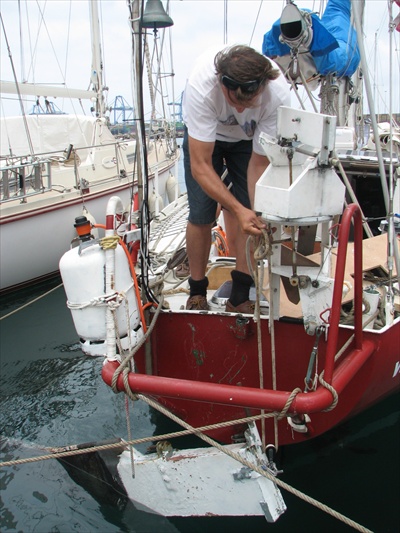 Re-installing auxiliary rudder. See story above.
Re-installing auxiliary rudder. See story above.
La Catedral de Santa Ana, Vegueta
Las Palmas, Gran Canaria, Canary Islands
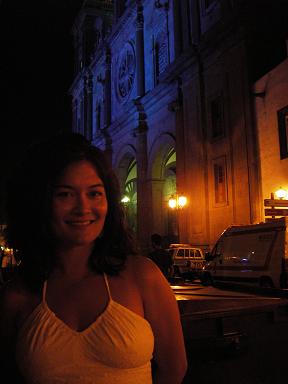 Knowing that Richard needed a break from boat work, I took him to Vegueta to show him the sights. We toured the cobblestone streets in the softening light of early evening, and dined at an outdoor cafe on authentic and delicious Canarian fare… papas con mojo (baby potatoes rolled in sea salt with a side of spicy pimento/garlic sauce……que sabrosa!), a rich Canarian stew of pork, carrots and garbanzos, and a paella de mariscos (seafood) that knocked our socks (sandals) off.
Knowing that Richard needed a break from boat work, I took him to Vegueta to show him the sights. We toured the cobblestone streets in the softening light of early evening, and dined at an outdoor cafe on authentic and delicious Canarian fare… papas con mojo (baby potatoes rolled in sea salt with a side of spicy pimento/garlic sauce……que sabrosa!), a rich Canarian stew of pork, carrots and garbanzos, and a paella de mariscos (seafood) that knocked our socks (sandals) off.  The big surprise of the night for Richard was that I’d learned previously in my scoutings that there would be a jazz concert held in La Plaza de Santa Ana–the beautiful square in front of the main Cathedral–the night I planned to take him out. So after dinner, we strolled to the Plaza, mingled with the festive mix of locals and tourists, and enjoyed the live jazz with the gorgeous backdrop of the Cathedral’s facade, illuminated with shifting, multicolored lights. It was a delightful evening, definitely securing our affections for the city of Las Palmas.
The big surprise of the night for Richard was that I’d learned previously in my scoutings that there would be a jazz concert held in La Plaza de Santa Ana–the beautiful square in front of the main Cathedral–the night I planned to take him out. So after dinner, we strolled to the Plaza, mingled with the festive mix of locals and tourists, and enjoyed the live jazz with the gorgeous backdrop of the Cathedral’s facade, illuminated with shifting, multicolored lights. It was a delightful evening, definitely securing our affections for the city of Las Palmas.
Neon Geraniums and Outdoor Market Front, Vegueta
Las Palmas, Gran Canaria, Canary Islands
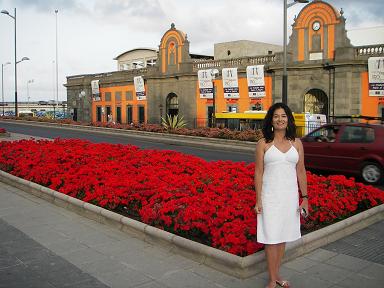 The incredible colors of Vegueta. Off to the left beyond the scope of the camera is the Bay of Las Palmas (one is never far from the water here).
The incredible colors of Vegueta. Off to the left beyond the scope of the camera is the Bay of Las Palmas (one is never far from the water here).
La Casa De Colon, Vegueta
Las Palmas, Gran Canaria, Canary Islands
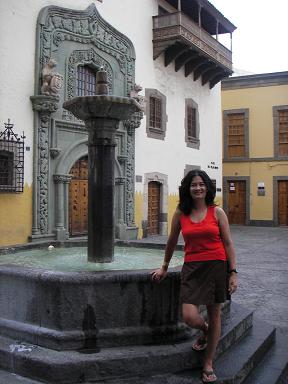 While Richard diligently worked on repairing the engine over the course of five days in Las Palmas, I diligently took it upon myself to become “Cultural Scout,” and scoped out the various neighborhoods, monuments and points of interest around the city. I was elated to discover Vegueta, the charming historic district of Las Palmas. Ancient buildings dating back to the 15th century, narrow, winding cobblestone streets, plazas, fountains, umbrella cafes strewn about every corner, and flowers bursting with color everywhere. The centerpiece of Vegueta is La Catedral de Santa Ana, an ancient cathedral with a Gothic interior but Neoclassical facade. Adjacent to the Cathedral is La Casa de Colon (The House of Christopher Columbus). Built in a classic “Canarian” style, it features an exotic and very intriguing mix of Spanish colonial, Gothic and Arabic influences. The prettiest features on the exterior were the graceful, Arabic wooden balconies of delicately carved lattice work. Combining these with the heavy stone carvings of Gothic gargoyles surrounding the doors made for a striking juxtaposition. The prettiest features in the interior of the building were the gorgeous and intricately detailed ship models of the Nina, the Pinta and the Santa Maria. Why were they there? La Casa de Colon has historically been the governor’s home of the city of Las Palmas, and in 1492, when Christopher Columbus was sailing in search of India, the rudder of the ship Pinta broke and became unhung. Rendering the ship disabled, the crew was able, however, to secure the rudder temporarily with cords until they reached the Canary Islands, namely Gran Canaria. According to Gran Canarian history, Cristobal Colon (Christopher Columbus) attended the home of the governor to pay his respects and gain official permission to dock the Pinta for repair, before continuing his mission. Columbus’s auspicious stop in Gran Canaria gave the governor’s home its present name, and is source of much pride to the citizens of Las Palmas. Interestingly, if you read the guide books, La Gomera claims to be the island where Columbus repaired the Pinta…while El Hierro insists that it was the one where he stopped. It seems that Columbus honored all of the islands of the Canaries by repairing a little bit of his rudder on each island. Well, sharing is caring, as they say, and perhaps the spirit of Christopher Columbus will be comforted to know that Richard and I would eventually (fatefully?)have a sympathy rudder adventure of our own in the Canaries. To be continued…. 😉
While Richard diligently worked on repairing the engine over the course of five days in Las Palmas, I diligently took it upon myself to become “Cultural Scout,” and scoped out the various neighborhoods, monuments and points of interest around the city. I was elated to discover Vegueta, the charming historic district of Las Palmas. Ancient buildings dating back to the 15th century, narrow, winding cobblestone streets, plazas, fountains, umbrella cafes strewn about every corner, and flowers bursting with color everywhere. The centerpiece of Vegueta is La Catedral de Santa Ana, an ancient cathedral with a Gothic interior but Neoclassical facade. Adjacent to the Cathedral is La Casa de Colon (The House of Christopher Columbus). Built in a classic “Canarian” style, it features an exotic and very intriguing mix of Spanish colonial, Gothic and Arabic influences. The prettiest features on the exterior were the graceful, Arabic wooden balconies of delicately carved lattice work. Combining these with the heavy stone carvings of Gothic gargoyles surrounding the doors made for a striking juxtaposition. The prettiest features in the interior of the building were the gorgeous and intricately detailed ship models of the Nina, the Pinta and the Santa Maria. Why were they there? La Casa de Colon has historically been the governor’s home of the city of Las Palmas, and in 1492, when Christopher Columbus was sailing in search of India, the rudder of the ship Pinta broke and became unhung. Rendering the ship disabled, the crew was able, however, to secure the rudder temporarily with cords until they reached the Canary Islands, namely Gran Canaria. According to Gran Canarian history, Cristobal Colon (Christopher Columbus) attended the home of the governor to pay his respects and gain official permission to dock the Pinta for repair, before continuing his mission. Columbus’s auspicious stop in Gran Canaria gave the governor’s home its present name, and is source of much pride to the citizens of Las Palmas. Interestingly, if you read the guide books, La Gomera claims to be the island where Columbus repaired the Pinta…while El Hierro insists that it was the one where he stopped. It seems that Columbus honored all of the islands of the Canaries by repairing a little bit of his rudder on each island. Well, sharing is caring, as they say, and perhaps the spirit of Christopher Columbus will be comforted to know that Richard and I would eventually (fatefully?)have a sympathy rudder adventure of our own in the Canaries. To be continued…. 😉
Dinghy Escapades
Las Palmas, Gran Canaria, Canary Islands
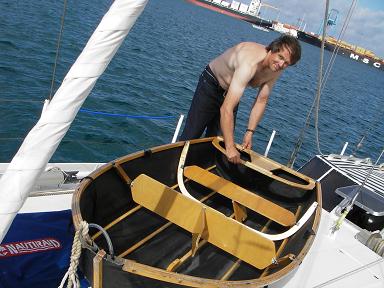 In spite of our mercurial engine, we arrived safely in Puerto de Las Palmas, Gran Canaria, and anchored off to the side of the marina, in front of one of the city beaches. Each morning we enjoyed the sound of children laughing and calling to one another as they flew by Issuma in tiny but speedy dinghies and mini sailboards. Richard immediately undertook repair of the engine, which called for multiple trips to the various ferreterias (hardware stores) in the city over the next few days. Because we were anchored, this entailed assembling the mysterious “Dark Dinghy” (mentioned in a previous entry) in order to reach shore. The design of the dinghy is quite amazing. It’s a collapsible frame that one opens like an enclosing fan, into which you place the floorboards and extra ribs to keep the dinghy open and set. The great thing about the dinghy is that you can collapse and store it in the V-berth. Also, it’s pretty. The tricky thing about the dinghy is that you need A LOT of weight in it in order to be able to row it straight and to not have it slide sideways or spin aimlessly like a top. I discovered this delightful feature one day when I gallantly insisted on rowing the groceries out to Issuma by myself, via Dark Dinghy. This would allow Richard to continue doing his onshore projects. I suppose we all bite off more than we can chew once in a while. It would turn out to be quite apt and prescient that I’d named it Dark Dinghy before ever meeting it.Richard helped me load the dinghy with the groceries, then waved and smiled as I made a lopsided but bravely grinning departure from the dock. What had I gotten myself into? When Richard rowed us in the dinghy to and from shore, I noticed it took him about 15 minutes. So naturally I thought it would only take me 20 minutes or so. Who was I kidding? Getting out of the marina harbor with no current was not much of a problem, but the moment I rounded the bend of the protective jetty, I began sliding and spinning like a leaf in a whirlpool, even with all the groceries weighting the dinghy! Ay Dio! I began to row like a madwoman, desperately trying to round the jetty towards Issuma, much to the amusement of the salty old local fishermen on the pier, pointing and cackling at the gringa loca twirling wildly between their fishing lines. Laughing uncontrollably and sweating profusely, I managed to seize control of the dinghy, through sheer humiliation and wanting to escape the laughter of the fishermen as soon as possible (also to avoid ending up in Africa
In spite of our mercurial engine, we arrived safely in Puerto de Las Palmas, Gran Canaria, and anchored off to the side of the marina, in front of one of the city beaches. Each morning we enjoyed the sound of children laughing and calling to one another as they flew by Issuma in tiny but speedy dinghies and mini sailboards. Richard immediately undertook repair of the engine, which called for multiple trips to the various ferreterias (hardware stores) in the city over the next few days. Because we were anchored, this entailed assembling the mysterious “Dark Dinghy” (mentioned in a previous entry) in order to reach shore. The design of the dinghy is quite amazing. It’s a collapsible frame that one opens like an enclosing fan, into which you place the floorboards and extra ribs to keep the dinghy open and set. The great thing about the dinghy is that you can collapse and store it in the V-berth. Also, it’s pretty. The tricky thing about the dinghy is that you need A LOT of weight in it in order to be able to row it straight and to not have it slide sideways or spin aimlessly like a top. I discovered this delightful feature one day when I gallantly insisted on rowing the groceries out to Issuma by myself, via Dark Dinghy. This would allow Richard to continue doing his onshore projects. I suppose we all bite off more than we can chew once in a while. It would turn out to be quite apt and prescient that I’d named it Dark Dinghy before ever meeting it.Richard helped me load the dinghy with the groceries, then waved and smiled as I made a lopsided but bravely grinning departure from the dock. What had I gotten myself into? When Richard rowed us in the dinghy to and from shore, I noticed it took him about 15 minutes. So naturally I thought it would only take me 20 minutes or so. Who was I kidding? Getting out of the marina harbor with no current was not much of a problem, but the moment I rounded the bend of the protective jetty, I began sliding and spinning like a leaf in a whirlpool, even with all the groceries weighting the dinghy! Ay Dio! I began to row like a madwoman, desperately trying to round the jetty towards Issuma, much to the amusement of the salty old local fishermen on the pier, pointing and cackling at the gringa loca twirling wildly between their fishing lines. Laughing uncontrollably and sweating profusely, I managed to seize control of the dinghy, through sheer humiliation and wanting to escape the laughter of the fishermen as soon as possible (also to avoid ending up in Africa  ). Rowing became easier as I approached Issuma in the small harbor, and by the end of this “adventure,” it had taken me not twenty, but FORTY-FIVE MINUTES to reach Issuma. It occurred to me that I could have driven from New Jersey to New York in that time, and I was only transporting groceries! After this enlightening experience, I decided that my efforts and gallant intentions were better applied elsewhere…at least until we get a motorized dinghy.
). Rowing became easier as I approached Issuma in the small harbor, and by the end of this “adventure,” it had taken me not twenty, but FORTY-FIVE MINUTES to reach Issuma. It occurred to me that I could have driven from New Jersey to New York in that time, and I was only transporting groceries! After this enlightening experience, I decided that my efforts and gallant intentions were better applied elsewhere…at least until we get a motorized dinghy. 
From Punta de Antiquera, Tenerife to Las Palmas, Part II
Canary Islands
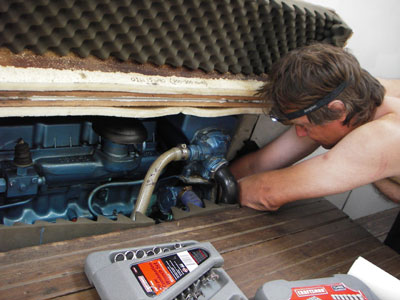 Sailing the ocean is more than a little different from sailing Long Island Sound. The seas are higher, the breeze is stiffer, and Issuma is a lot of boat to sail (21 tons of steel schooner, 15.3 meters/52 feet long!). She’s a very fast boat, which is fantastic, but because she’s a big, stiff boat, all of her hardware, fittings, and running rigging are also big and stiff (the spring line is the size of an adult Amazonian Python). Lots of tugs-of-war, muttered expletives and switching from short to long-fingered gloves attest to this. In spite of the struggles, learning how to sail Issuma is a lot of fun. Richard taught me how to use the wind vane, read the fishfinder for depth, and how to use the roller furlers for the voile d’etai and trinquette. I’d have to attend body-building school for a year before I could ever raise the mainsail, but Richard can take care of that.Also, while ocean sailing is fun and exciting, it is not exactly relaxing. In fact, it’s mentally exhausting as you must remain ever-alert and constantly checking your heading, making adjustments with the windvane, checking speed, and constantly looking out for boat traffic. We crossed a TSS (Traffic Separation Scheme) between Tenerife and Gran Canaria, and had to look out and give way for any commercial vessels moving in either lane. At one point it appeared that an enormous, 4-domed liquified gas tanker was headed straight for our starboard side. I was feeling un poco concerned. Fortunately, though, we began to see more of the tanker’s starboard and it passed peacefully behind us….liquid explosives and all. It was a tender moment.We were concerned about how we would enter a new, unknown harbor and anchor safely without our engine. When I stood watch, Richard investigated the engine’s malfunction, and discovered that one of the engine cooling pipes had developed holes in a very difficult-to-reach spot. This had caused the engine to lose its coolant and overheat. He assiduously worked on temporarily repairing the engine with epoxy, and because of his efforts, we had limited use of the engine for our entry into Las Palmas harbor. Thank Poseidon, because attempting to enter this busy harbor–blinded by the setting sun and with a stream of giant freighters barreling out of it–was like New York Harbor on steroids. Given our very limited understanding of Spanish further hampered by static, we were unable to determine from the radio what the freighters’ plans were. We were still under sail as a giant freighter, Catania, played mind games as it waited with us to enter the harbor. It would turn, so we would tack, then it would turn again, and we would tack again. Finally, we were only a few hundred meters from the entrance, and doing 5 knots, when another freighter emerged from the harbor’s mouth. In spite of our bittersweet proximity to the entrance, we conceded in the face of this behemoth, tacked over and away from the entrance. At this point, Catania had moved forward and entered the harbor, and we followed in Catania’s wake, figuring that no other freighter would be near the narrow entrance at the same time.Gleefully entering the harbor, we were somewhat dismayed to see yet another monster freighter, Gruppo Boludo, come charging around the corner. At this point, though, we were able to stay out of the way of Gruppo Boludo, and safely sail in. Thankfully, Gruppo Boludo was the last of the departing giants, and we safely continued forward into the harbor. Phew! Turning on the engine and dropping sail, we found Marina de Las Palmas, and successfully dropped anchor north of the marina. The flat bay and light breeze is a pleasant contrast to the chop and gusty winds of Punta Antiquera of Tenerife the night before. Now it’s time to hit the ferreterias and more fully repair the engine. Ahhhh, sailing.
Sailing the ocean is more than a little different from sailing Long Island Sound. The seas are higher, the breeze is stiffer, and Issuma is a lot of boat to sail (21 tons of steel schooner, 15.3 meters/52 feet long!). She’s a very fast boat, which is fantastic, but because she’s a big, stiff boat, all of her hardware, fittings, and running rigging are also big and stiff (the spring line is the size of an adult Amazonian Python). Lots of tugs-of-war, muttered expletives and switching from short to long-fingered gloves attest to this. In spite of the struggles, learning how to sail Issuma is a lot of fun. Richard taught me how to use the wind vane, read the fishfinder for depth, and how to use the roller furlers for the voile d’etai and trinquette. I’d have to attend body-building school for a year before I could ever raise the mainsail, but Richard can take care of that.Also, while ocean sailing is fun and exciting, it is not exactly relaxing. In fact, it’s mentally exhausting as you must remain ever-alert and constantly checking your heading, making adjustments with the windvane, checking speed, and constantly looking out for boat traffic. We crossed a TSS (Traffic Separation Scheme) between Tenerife and Gran Canaria, and had to look out and give way for any commercial vessels moving in either lane. At one point it appeared that an enormous, 4-domed liquified gas tanker was headed straight for our starboard side. I was feeling un poco concerned. Fortunately, though, we began to see more of the tanker’s starboard and it passed peacefully behind us….liquid explosives and all. It was a tender moment.We were concerned about how we would enter a new, unknown harbor and anchor safely without our engine. When I stood watch, Richard investigated the engine’s malfunction, and discovered that one of the engine cooling pipes had developed holes in a very difficult-to-reach spot. This had caused the engine to lose its coolant and overheat. He assiduously worked on temporarily repairing the engine with epoxy, and because of his efforts, we had limited use of the engine for our entry into Las Palmas harbor. Thank Poseidon, because attempting to enter this busy harbor–blinded by the setting sun and with a stream of giant freighters barreling out of it–was like New York Harbor on steroids. Given our very limited understanding of Spanish further hampered by static, we were unable to determine from the radio what the freighters’ plans were. We were still under sail as a giant freighter, Catania, played mind games as it waited with us to enter the harbor. It would turn, so we would tack, then it would turn again, and we would tack again. Finally, we were only a few hundred meters from the entrance, and doing 5 knots, when another freighter emerged from the harbor’s mouth. In spite of our bittersweet proximity to the entrance, we conceded in the face of this behemoth, tacked over and away from the entrance. At this point, Catania had moved forward and entered the harbor, and we followed in Catania’s wake, figuring that no other freighter would be near the narrow entrance at the same time.Gleefully entering the harbor, we were somewhat dismayed to see yet another monster freighter, Gruppo Boludo, come charging around the corner. At this point, though, we were able to stay out of the way of Gruppo Boludo, and safely sail in. Thankfully, Gruppo Boludo was the last of the departing giants, and we safely continued forward into the harbor. Phew! Turning on the engine and dropping sail, we found Marina de Las Palmas, and successfully dropped anchor north of the marina. The flat bay and light breeze is a pleasant contrast to the chop and gusty winds of Punta Antiquera of Tenerife the night before. Now it’s time to hit the ferreterias and more fully repair the engine. Ahhhh, sailing. 
From Punta de Antiquera, Tenerife to Las Palmas, Gran Canaria, Part 1
Canary Islands
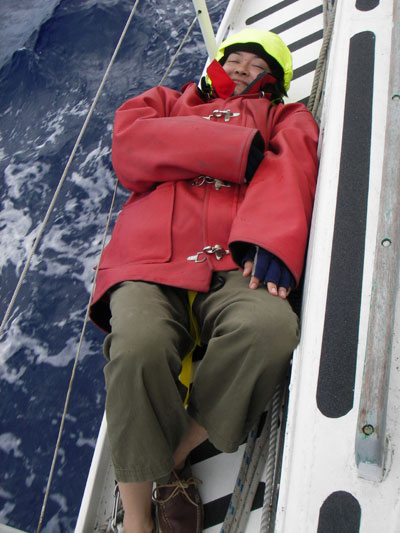 The 5th of July would prove to be quite an eventful day. Sailing from Punta de Antiquera, Tenerife to Las Palmas, Gran Canaria would be approximately 50 miles. A day sail, but a long one (for me!). Therefore, we were up relatively early and got the boat ready. We turned the engine on, picked up anchor, and slowly began heading out of the bay. I was at the helm, Richard had raised the voile d’etai (main staysail), when suddenly the engine over-temperature alarm went off. Richard quickly shut off the engine and raised the mainsail, but because we were not yet out of the bay, the flukey bay winds put Issuma into irons. This was rather alarming as being in irons meant that we had no control of the boat. Richard instructed me to center the tiller as he raised the trinquette (fore staysail) to help balance the boat, while we waited for the winds to turn Issuma back to sea. Luckily, the sails filled, and in spite of no engine, we made it past the arms of the bay, headed out to sea and set sail for Gran Canaria.Issuma was sailing beautifully on the crashing sea, moving anywhere from 5.2 to 6.9 knots during the morning sail. Richard raised and trimmed sails while I stood at the helm. After the first hour of the sail, I felt strangely sleepy and sick. I thought it was indigestion, but Richard recognized my symptoms as seasickness. Mortified (how could I get seasick?), I sheepishly agreed to take the medicine, and promptly passed out on the deck of the boat flat on my back, bundled in 3 foulweather jackets and two hats, with a checkered dishtowel covering my face from the seaspray. I was unconscious for nearly 2 hours, but it was very restorative as I woke up feeling quite chipper and ready to be a crew member–rather than an invalid–again.
The 5th of July would prove to be quite an eventful day. Sailing from Punta de Antiquera, Tenerife to Las Palmas, Gran Canaria would be approximately 50 miles. A day sail, but a long one (for me!). Therefore, we were up relatively early and got the boat ready. We turned the engine on, picked up anchor, and slowly began heading out of the bay. I was at the helm, Richard had raised the voile d’etai (main staysail), when suddenly the engine over-temperature alarm went off. Richard quickly shut off the engine and raised the mainsail, but because we were not yet out of the bay, the flukey bay winds put Issuma into irons. This was rather alarming as being in irons meant that we had no control of the boat. Richard instructed me to center the tiller as he raised the trinquette (fore staysail) to help balance the boat, while we waited for the winds to turn Issuma back to sea. Luckily, the sails filled, and in spite of no engine, we made it past the arms of the bay, headed out to sea and set sail for Gran Canaria.Issuma was sailing beautifully on the crashing sea, moving anywhere from 5.2 to 6.9 knots during the morning sail. Richard raised and trimmed sails while I stood at the helm. After the first hour of the sail, I felt strangely sleepy and sick. I thought it was indigestion, but Richard recognized my symptoms as seasickness. Mortified (how could I get seasick?), I sheepishly agreed to take the medicine, and promptly passed out on the deck of the boat flat on my back, bundled in 3 foulweather jackets and two hats, with a checkered dishtowel covering my face from the seaspray. I was unconscious for nearly 2 hours, but it was very restorative as I woke up feeling quite chipper and ready to be a crew member–rather than an invalid–again.